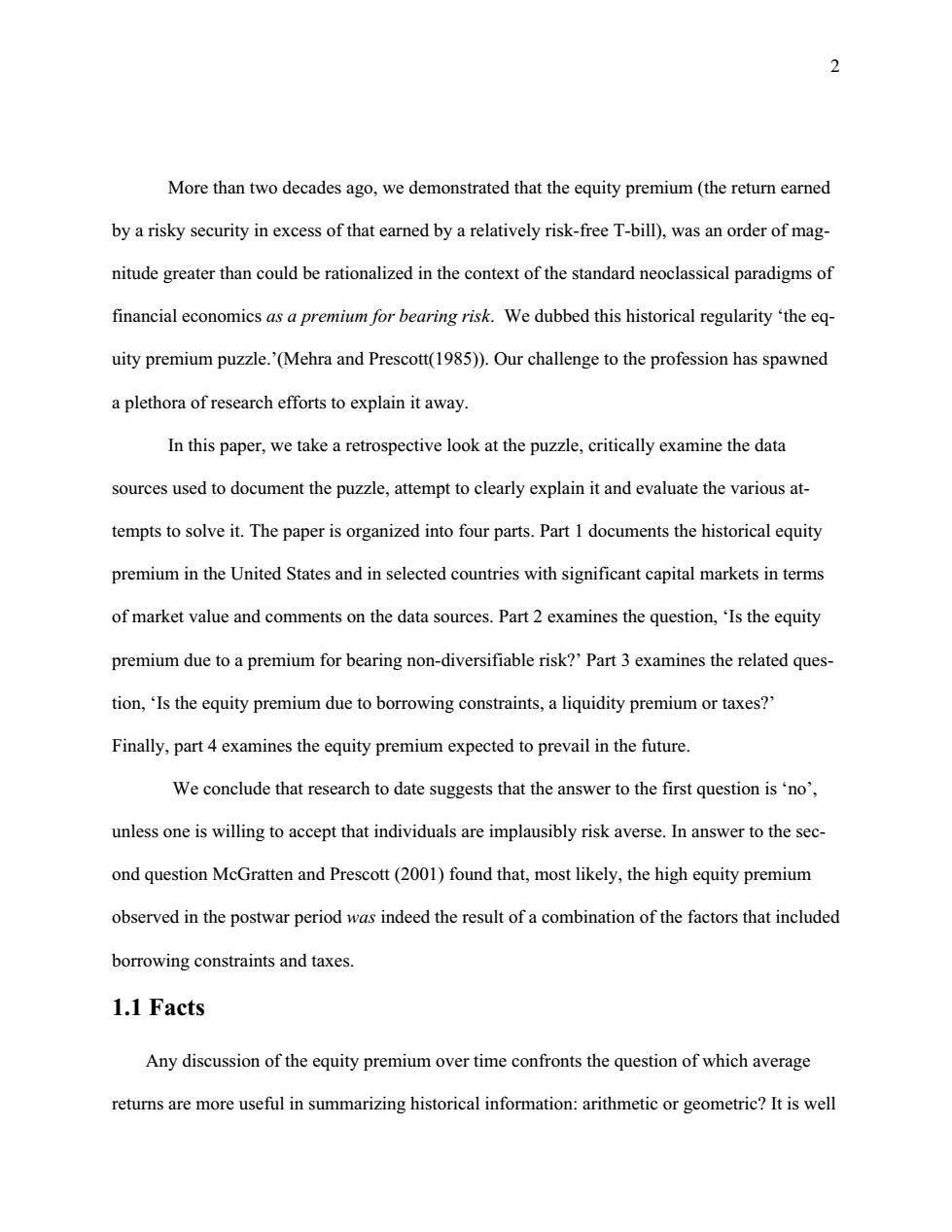正在加载图片...

2 More than two decades ago,we demonstrated that the equity premium(the return earned by a risky security in excess of that earned by a relatively risk-free T-bill),was an order of mag- nitude greater than could be rationalized in the context of the standard neoclassical paradigms of financial economics as a premium for bearing risk.We dubbed this historical regularity 'the eq- uity premium puzzle.'(Mehra and Prescott(1985)).Our challenge to the profession has spawned a plethora of research efforts to explain it away. In this paper,we take a retrospective look at the puzzle,critically examine the data sources used to document the puzzle,attempt to clearly explain it and evaluate the various at- tempts to solve it.The paper is organized into four parts.Part 1 documents the historical equity premium in the United States and in selected countries with significant capital markets in terms of market value and comments on the data sources.Part 2 examines the question,'Is the equity premium due to a premium for bearing non-diversifiable risk?'Part 3 examines the related ques- tion,'Is the equity premium due to borrowing constraints,a liquidity premium or taxes?' Finally,part 4 examines the equity premium expected to prevail in the future. We conclude that research to date suggests that the answer to the first question is 'no', unless one is willing to accept that individuals are implausibly risk averse.In answer to the sec- ond question McGratten and Prescott(2001)found that,most likely,the high equity premium observed in the postwar period was indeed the result of a combination of the factors that included borrowing constraints and taxes. 1.1 Facts Any discussion of the equity premium over time confronts the question of which average returns are more useful in summarizing historical information:arithmetic or geometric?It is well2 More than two decades ago, we demonstrated that the equity premium (the return earned by a risky security in excess of that earned by a relatively risk-free T-bill), was an order of magnitude greater than could be rationalized in the context of the standard neoclassical paradigms of financial economics as a premium for bearing risk. We dubbed this historical regularity ‘the equity premium puzzle.’(Mehra and Prescott(1985)). Our challenge to the profession has spawned a plethora of research efforts to explain it away. In this paper, we take a retrospective look at the puzzle, critically examine the data sources used to document the puzzle, attempt to clearly explain it and evaluate the various attempts to solve it. The paper is organized into four parts. Part 1 documents the historical equity premium in the United States and in selected countries with significant capital markets in terms of market value and comments on the data sources. Part 2 examines the question, ‘Is the equity premium due to a premium for bearing non-diversifiable risk?’ Part 3 examines the related question, ‘Is the equity premium due to borrowing constraints, a liquidity premium or taxes?’ Finally, part 4 examines the equity premium expected to prevail in the future. We conclude that research to date suggests that the answer to the first question is ‘no’, unless one is willing to accept that individuals are implausibly risk averse. In answer to the second question McGratten and Prescott (2001) found that, most likely, the high equity premium observed in the postwar period was indeed the result of a combination of the factors that included borrowing constraints and taxes. 1.1 Facts Any discussion of the equity premium over time confronts the question of which average returns are more useful in summarizing historical information: arithmetic or geometric? It is well